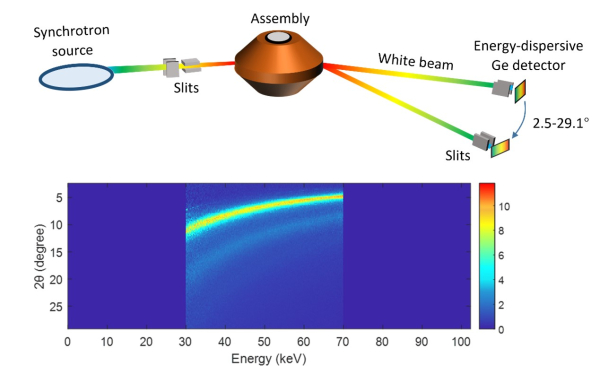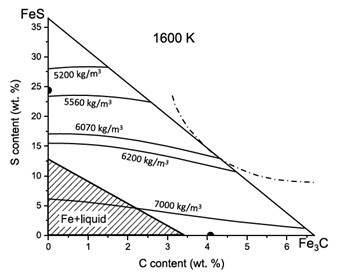Despite numerous geophysical and geochemical studies, the properties of the Moon's core, and in particular its density, remain poorly understood. The core density is closely linked to its composition, a crucial piece of information for understanding the Moon's origin and evolution. Researchers from IMPMC, Sorbonne University and ISTerre, Grenoble Alpes University, have employed X-ray diffraction and absorption techniques to measure the density of liquid Fe-C-S alloys—a ternary alloy made of elements considered to be potential components of the Moon core. Thanks to the unique capabilities of the PSICHE beamline, these measurements were conducted under the high pressure and temperature conditions existing within the Moon's core. The thermodynamic model constructed on the base of the obtained data serves as a valuable tool for discussing the composition of the core of the Moon, but as well the cores of other small terrestrial planetary bodies.
The Moon is the only planetary body, besides Earth, for which extensive seismic, geodetic and electromagnetic data have been acquired. Despite this wealth of information, major questions remain open regarding its deepest regions, and the exact composition of its liquid core remains unknown. While iron is known to be present, pure iron is too dense and its melting point too high to be the only element comprising the Moon core. In view of their cosmochemical abundance and chemical affinity to iron, carbon and sulfur have been suggested to be light elements incorporated with iron into the Moon core, but current studies are limited to the Fe-S and Fe-C binary systems, which individually cannot account for the properties of the Moon core. Therefore, the study of the Fe-C-S system and the determination of the density of the ternary liquid at pertinent pressure and temperature conditions are expected to provide a better understanding of the Moon's core composition and its evolution since core formation. However, measuring the density of liquids under high pressure and temperature is extremely challenging due to the complexity of the required techniques.
By exploiting the available instrumentation on the PSICHE beamline and establishing a protocol allowing multi-technique measurements under such extreme conditions, researchers from IMPMC, Sorbonne University and ISTerre, Grenoble Alpes University, in collaboration with the beamline staff, have recently made significant progress in measuring the density of Fe-C-S liquid samples. The team conducted experiments using a Paris-Edinburgh cell, a laboratory device capable of creating high-pressure conditions ranging from 1 to 7 GPa, equivalent to 10,000 to 70,000 times Earth's atmospheric pressure, and temperatures as high as 2000 K, approximately 1725 °C. In this cell, they studied a series of samples with varying carbon and sulfur contents. Analyses were performed using X-ray diffraction and absorption techniques. This is the first data of its kind for ternary Fe-S-C alloys under conditions existing within the Moon core (pressure of the order of 4 to 5 GPa and temperatures estimated between 1600 and 1900 K). The experimentally determined densities were then used to build a thermodynamic model describing the density of liquid Fe-C-S alloys as a function of pressure, temperature, and light element content (C and S).

Figure 1: A schematic representation of the CAESAR (Combined Angle and Energy Dispersive Structure Analysis and Refinement)) X-ray diffraction technique (top) allowing the collection of high-quality signal over the extended energy and 2θ range necessary to determine local structure and density for liquid samples (bottom).
This new density model has significant implications for understanding the properties and behaviors of Fe-C-S liquids, providing new insights into the Moon's core composition. Referring to three of the most recent Moon compositional models—derived from seismic, electromagnetic, geodetic, and geochemical data, proposing either partially or fully melted cores—this new thermodynamic model allows the deduction of potential carbon and sulfur contents in the core. However, due to relatively significant discrepancies among the three Moon models, sulfur and carbon contents vary considerably from one model to another. The Farside Seismic Suite (FSS) mission by NASA will deliver in 2025 two of the most sensitive flight-ready seismometer ever built to Schrödinger Crater on the far side of the Moon. Improved geophysical observations will enable us to better constrain the density of the lunar core, which in turn, thanks to the thermodynamic model here-developed, will be correlated with a more tightly constrained composition.

Figure 2: Ternary diagram showing the range of possible sulfur and carbon content in the liquid (outer) core of the Moon, assumed at 5 GPa and 1600 K, with density fixed according to three of the most recent lunar models: (i) G19 – fully molten core with density in the range 4200-5200 kg/m3 corresponding to a S content in the range 27-36 wt% and a C content between 2 and 0 wt%; (ii) V19 (Viswanathan et al., 2019) - fully molten core with density in the range 5560-6070 kg/m3 corresponding to a S content in the range 17-23 wt% and a C content between 4.5 and 0 wt%; (iii) K21– solid inner core made of Fe (+C at solubility limit) surrounded by a liquid core with a density in the range 6200-7000 kg/m3 corresponding to a S in the range 6-13 wt% and a C content between 2.3 and 0 wt%.
The shaded triangle indicates the composition range where solid Fe phase (+C at the solid solubility limit) is expected to coexist with Fe-C-S liquid. The dot-dashed line represents the miscibility domain at 5 GPa for Fe-C-S liquid alloys. Eutectic compositions for Fe-S and Fe-C binary systems at 5 GPa are also marked by closed circles on the axes.
